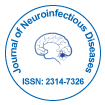Breif Note On Myoclonic Seizures.
DOI: 10.4172/2314-7326.1000344
Abstract
Myoclonic seizures are sudden jerks of a muscle or a group of muscles. "Myo" denotes muscle, and "clonus" (KLOH-nus) indicates fast muscle contraction and relaxation (jerking or twitching). They usually last no more than a second or two. There may be only one, but there may be several in a short period of time.There may be only one, but there may be several in a short period of time. Myoclonic seizures are epilepsy symptoms that induce abnormal movements on both sides of the body at the same time. They can be found in a variety of epileptic syndromes, each with its own set of symptoms.The convulsions in juvenile myoclonic epilepsy frequently affect the neck, shoulders, and upper arms. Seizures commonly occur shortly after waking up in many individuals. In people with a normal range of IQ, they normally start around adolescence or early adulthood.
Keywords: Myoclonic seizure, Epilepsy
Breif Note On Myoclonic Seizures
In most situations, medicine can effectively manage seizures, but it must be continued for the rest of one’s life.Lennox-Gastaut syndrome: This is an uncommon syndrome that usually includes other types of seizures as well. It begins in early childhood. They may be quite strong and are difficult to control.Rare epilepsy syndromes with a mix of myoclonic and tonic-clonic seizures are classified as progressive myoclonic epilepsy. Treatment is rarely effective for long, as the patient’s condition deteriorates with time.Myoclonic seizures are characterised by jerking spasms of a single muscle or a group of muscles. They are frequently associated with atonic seizures, which produce muscle limpness. Myoclonus can be described as brief jerks of the body [1].Stop what you’re doing if you think you’re having a myoclonic seizure. During the seizure, stay as still as possible.Make sure no one else is hurt if someone else is suffering a myoclonic seizure. Clear the area around them and stay with them until the seizure is over.Remember that myoclonic seizures are only temporary. Juvenile myoclonic epilepsy (JME), also known as Janz syndrome, is a fairly common form of generalized epilepsy of presumed genetic origin (previously known an idiopathic generalized epilepsy) [2].They usually only last a few seconds. Concentrate on remaining safe and minimising the chance of injury.The goal of management is to get the person seizure-free without the medication’s negative effects. JME necessitates lifetime treatment because seizures almost usually reappear after therapy is stopped. Anti-seizure (or antiepileptic) drugs can be quite beneficial. Finding the proper medicine and dosage may take a few trials. To choose the appropriate drug, the doctor will look for adverse effects.Certain lifestyle adjustments may also be used: A high-fat, low-carbohydrate diet may be used (ketogenic diet), Getting a good night’s sleep, Certain triggers, such as flickering lights, should be avoided.Juvenile myoclonic epilepsy is an inherited genetic syndrome, but the way in which this disorder is inherited is unclear. JME have relatives with a history of epileptic seizures. There is also a higher rate of females showing JME symptoms than males [3].
References
Share This Article
Recommended Journals
Open Access Journals
Article Tools
Article Usage
- Total views: 1606
- [From(publication date): 0-2021 - Feb 22, 2025]
- Breakdown by view type
- HTML page views: 1053
- PDF downloads: 553
